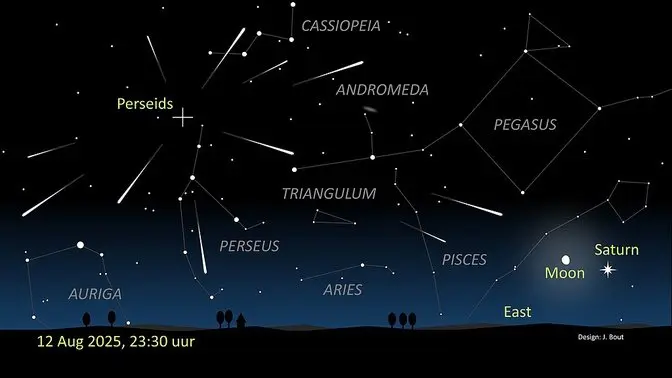As the summer nights stretch long and warm, a celestial event of extraordinary beauty beckons us to the sky: the Perseid meteor shower. This annual spectacle, one of the most anticipated and spectacular of the year, reminds us of the vastness and mystery of the universe.
A Cosmic Dance of Light
From July 17 to August 24, 2025, Earth will travel through the debris trail left by comet Swift-Tuttle. This cosmic stream, filled with tiny particles and rocky fragments, ignites in Earth's atmosphere, creating the bright streaks of light we call meteors. At speeds of up to 36 miles per second, these particles, often no bigger than a grain of sand, vaporize, leaving behind a fiery trail.

At its peak, expected around August 12, 2025, the Perseid meteor shower can produce up to 150 meteors per hour, filling the sky with dazzling fireballs and luminous streaks. These meteors, which seem to radiate from the constellation Perseus, can appear anywhere in the night sky, making the experience all the more magical.
What is the Perseid Meteor Shower?
The Perseids are linked to comet 109P/Swift-Tuttle, which sheds debris as it moves through the solar system. Each year, Earth passes through this debris, and the particles burn up upon entering our atmosphere, creating the stunning light displays we call shooting stars. The Perseids are famous for their fireballs—meteors that shine brighter and longer than typical shooting stars.

When and How to Watch
The Perseid meteor shower will be active from July 17 to August 24, 2025, with the peak expected around August 12. For the best viewing experience, head outside between midnight and dawn, when the radiant point (the area of the sky where the meteors appear to originate) is highest in the sky.
Although the Full Moon in 2025 may create some light pollution, the Perseids will still be visible. To enhance your chances, find a dark, open space away from city lights, and enjoy the sky in a wide, relaxed view.

The longer you wait, the more meteors you’ll see—so take your time and enjoy the experience. It’s worth giving your eyes about 20 minutes to adjust to the darkness.
Tips for Viewing Success
Find a Dark Location: Escape light pollution by heading to rural areas or parks. The further from city lights, the better.
Dress Comfortably: Nights can get cool, so bring a blanket or reclining chair for comfort, especially if you plan to stay out early in the morning.
Plan for Peak Times: The best time to view the Perseids is between midnight and dawn, with the radiant point highest just before sunrise.
Give Your Eyes Time to Adjust: Allow 20 minutes for your eyes to adjust to the darkness before you start watching.
Relax and Enjoy: The Perseids can appear anywhere in the sky, so keep your gaze wide and relaxed, and let the meteors paint the sky with their brief but beautiful flashes.

A Night of Wonder
This August, take a moment to look up and let the Perseid meteor shower remind you of the wonder that lies just above our heads. Whether you’re watching with friends, family, or alone, this celestial event offers an opportunity to reflect on the vastness of space, the passage of time, and our small but significant place within it.

As the meteors streak across the sky, let them inspire you to dream bigger, to reach higher, and to embrace the infinite possibilities of the universe. The Perseid meteor shower is not just a visual feast but a cosmic invitation to wonder and curiosity.
Clear skies and happy stargazing!
Subscribe to The Bright Story and step into a world of hope, wonder, and humanity at its best. With unlimited access, discover powerful personal journeys, heartwarming family and animal stories, incredible discoveries, and the everyday kindness that makes life brighter.